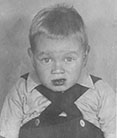Search for Names, Places and Biographies
Already layed Stumbling Stones
Suche

© Archiv Evangelische Stiftung Alsterdorf
Hans-Peter Harder * 1939
Winterhuder Weg 11 (Hamburg-Nord, Uhlenhorst)
HIER WOHNTE
HANS-PETER HARDER
JG.1939
"EINGEWIESEN" 1942
ALSTERDORFER ANSTALTEN
"VERLEGT" 7.8.1943
IDSTEIN / KALMENHOF
"KINDERFACHABTEILUNG"
ERMORDET 9.9.1943
further stumbling stones in Winterhuder Weg 11:
Johanna Führt, Horst Langeloh
Hans-Peter Harder, born 23.12.1939 in Hamburg, after infant home, small children's home and the former Alsterdorfer Anstalten (today Evangelische Stiftung Alsterdorf), "transferred" on 7.8.1943 to the Kalmenhof sanatorium and nursing home in Idstein, died 9.9.1943
Winterhuder Weg 11 (Uhlenhorst)
Hans-Peter Harder was born on Dec. 23, 1939 in the Finkenau Women's Clinic in Hamburg-Uhlenhorst. His unmarried mother, Wilma Harder, born in Hamburg on Oct. 8, 1915, was 24 years old at his birth. His natural father was the seaman Bruno Mielke, born in 1919, who was called up to the navy at the time of Hans-Peter's birth.
Wilma Harder had already had a child on Febr. 8, 1937, about whom we do not know any details. According to the files, she had had a problematic childhood and youth: her father was unknown, her mother was said to have lived an "unsound" life. When she was thirteen years old, Wilma Harder was described in an expert opinion as a "difficult-to-educate psychopathic child". She had left school after the third grade (the first grade was the highest at that time), came into the care of the welfare education and lived for some time in the Birkenhof reformatory in Hanover-Kirchrode. Obviously she was not able to care for the child.
Hans-Peter Harder was therefore transferred from the maternity hospital to the Wilhelm Foundation's infant home in Rahlstedt, which was open at the time. When he had left this behind, he was first admitted to the Johannes-Petersen-Heim in Volksdorf in July 1941 and in August of that year to the state-run infant home at Winterhuder Weg 11 in the Uhlenhorst district.
There it was said about the two-and-a-half-year-old: "Neurologically all right. Physically in good condition. Sits and stands alone. It is difficult to get in touch with Hans-Peter because he is not interested in anything. When approached, he usually reacts by crying. He doesn't speak a word yet, doesn't babble like other children of his age, plays for himself, but without real sympathy. As far as one can tell at this age, Hans-Peter seems to be mentally backward. An in-care assignment cannot be advocated. I recommend transfer to a home for inferior children. Signed Dr. Bosse."
The patient file contains no indication of whether Hans-Peter ever received loving attention and playful or communicative stimulation during his home life.
On March 3, 1942, Hans-Peter Harder's admission to the then Alsterdorfer Anstalten (today's Evangelische Stiftung Alsterdorf) was prepared with the following justification: "The patient's admission to the Alsterdorfer Anstalten is necessary due to idiocy and developmental arrest. [...] Strong motor restlessness, cannot be left alone for a moment. Makes no attempts to speak, uninterested, sluggish, dull. Gez. Dr. Gräfe".
This negative picture is not matched by what was recorded in the patient file of Hans-Peter, now three years old, on January 6, 1943: "Patient is very lively in nature, he takes a lively interest in his surroundings. He tries to speak, repeats words, he now walks well on his own. He likes to play with toys, eats alone under supervision, and is given a full diet. During the day he can be kept dry. At night he is wet."
Possibly this good development would have continued if Hans-Peter Harder had been given the time to do so. But the director of the institution, SA member Pastor Friedrich Lensch, took advantage of the damage suffered by the Alsterdorf institutions during the heavy air raids on Hamburg in the summer of 1943 ("Operation Gomorrah") to get rid of difficult and costly nursing cases. He asked the health authorities for approval to transfer 750 patients, ostensibly to make room for wounded and bomb-damaged patients. As a result, three transports with a total of 469 girls, boys, women and men left Alsterdorf in different directions between August 7 and 16, 1943.
Hans-Peter Harder was assigned to the transport of 128 boys and men on August 7, 1943, 76 of whom were taken to the "Landesheilanstalt Eichberg" near Wiesbaden and 52 boys between the ages of two and twelve, among them Hans-Peter Harder, to the "Heil- und Pflegeanstalt Kalmenhof".
Founded in 1888, the Kalmenhof Institution was originally a progressive educational institution for people with mental disabilities. But then it had been included in the "euthanasia" program of "Aktion-T4" (a camouflage designation after the location of the Berlin euthanasia headquarters at Tiergartenstraße 4) in 1939. Patients were transferred from there to the neighboring Hadamar killing facility and murdered. After the official stop of the euthanasia murders in August 1941, a "children's specialist department" of the "euthanasia" camouflage organization with the disguising name "Reichsausschuss zur wissenschaftlichen Erfassung erb- und anlagebedingter schwerer Leiden" (Reich Committee for the Scientific Registration of Hereditary and Congenital Severe Sufferings) was established in Kalmenhof, where children were killed by overdosed drugs such as Luminal, scopolamine or morphine.
Many of the children from Hamburg died only a few days after their arrival at the Kalmenhof, Hans-Peter Harder after one month on September 9, 1943.
Translation by Beate Meyer
Stand: February 2022
© Ingo Wille
Quellen: Evangelische Stiftung Alsterdorf, Archiv, Sonderakte V 053 (Hans-Peter Harder); Standesamt Idstein, Sterberegisterauszug 162/1943 Hans-Peter Harder; Harald Jenner, Michael Wunder, Hamburger Gedenkbuch Euthanasie – Die Toten 1939-1945, Hamburg 2017, S. 139. Michael Wunder, Ingrid Genkel, Harald Jenner, Auf dieser schiefen Ebene gibt es kein Halten mehr – Die Alsterdorfer Anstalten im Nationalsozialismus, Stuttgart 2016, S. 283 ff; https://www.aerzteblatt.de/archiv/24708/NS-Kindereuthanasie-Ohne-jede-moralische-Skrupel (Zugriff am 30.6.2021); https://de.wikipedia.org/wiki/Kalmenhof#Der_Kalmenhof_als_Zwischenanstalt (Zugriff am 4.7.2021).

